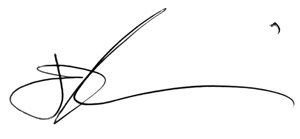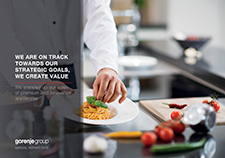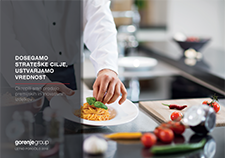President and CEO's Report
For Gorenje Group, the year 2016 was a year of successful operations that we only improved each quarter. We consistently pursued and accomplished our business goals laid down for the first year of our new strategic plan based on growth and global presence. Thus, larger volumes, better sales structure in terms of markets, brands, and products, and solid cost management, returned Gorenje to profitability after an arduous year 2015. We stepped up our appliance sales under all brands, with the highest increase for the premium Asko brand, as well as other premium and innovative appliances and Gorenje small domestic appliances. We unveiled our first connected appliances and consolidated our position in our strategic markets. With sound financial management, we cut the Group's relative debt and improved its profitability, while supporting its future growth with increased investment into development and marketing. In order to improve operational excellence, we have prepared comprehensive reorganization of the Group, placing even more emphasis to entrepreneurial spirit, while encouraging among the employees integrated thinking and reporting on the value we create for our key stakeholders. With these activities, we are building solid foundations for further attainment of our strategic goals.
The growth of our profitability was fuelled by improved sales structure in terms of markets, brands, and products
After an encouraging last quarter of 2015, solid Gorenje Group performance extended into 2016 and it has been steadily improving since. We wrapped up the year with revenue of EUR 1.258 billion, significant improvement in EBITDA which stood at EUR 87.2 million, and net profit of EUR 8.4 million.
We grew in all Gorenje Group geographical segments, most notably in Russia, Ukraine, and Eastern Europe, and we consolidated our market positions. At the same time, we are – consistently with our strategy – gradually advancing sales in markets beyond Europe where demand for home appliances is rising: Australia, USA, and Asia. Overall, we increased our revenue in the core activity Home by 3.4 percent.
The second profitability growth generator is the increase of the share of premium and innovative appliances which deliver higher value added. We stepped up our sales of premium appliances, and we sold 14.5 percent more innovative appliances, as well as cooking and dishwashing appliances. In addition, sales of small domestic appliances was up 32.4 percent.
Thirdly, and also notably, we drove up the sales of our products under all of our brands, with the premium brand Asko seeing the highest growth at 9 percent. By increasing our sales under the premium brands Asko and Atag, we are successfully improving our sales structure in terms of products. Premium and innovative appliances account for over 27 percent major domestic appliance revenue, although a 30-percent share was only planned for 2020.
Our investments into development are boosting our long-term competitive edge
Growth of profitability and improvement in sales structure, along with attainment of budgeted sales targets, are also supported with targeted marketing activities and investments into new product development, which are rising every year and amounted to 2.6 percent of total Gorenje Group revenue last year.
In a mature industry where we are competing with major global players for the attention of the consumers, we have established ourselves as a manufacturer driven by design and innovation, as substantiated by many prestigious international design awards won by our products also in 2016.
In order to explore user habits and needs, and to address the need for trend management, we set up a market and consumer research department. The winner in this race will be the one that best understands the end users, knows them well, and manages the global trends unfolding with ever greater pace in the world, like connectivity and digitization which are certainly at the centre of attention at the moment.
Digitization is an indispensable factor of business process and product development
At Gorenje Group, we are intensively pursuing our digital business strategy that involves all fields of our operations. We are implementing digitization in both business processes and products.
At last year's IFA tradeshow in Berlin, we presented a range of connected appliances of the Asko premium brand, featuring smart controls.
We are aware that the rapid pace of change in digitization compels us to continuously adapt the operational solutions to the new possibilities arising in the market. Thus, we are investing heavily in employee training in this direction. One effort in this respect is the digital academy which is becoming an important part of the Corporate University of Gorenje.
A year of cost efficiency and savings
Systematic approach to risk management established at the Gorenje Group ensures that business decisions and risks related thereto are identified, measured, and monitored at a strategic, operational, and project level. Involved in the risk management process are all employees who are exposed to risks and opportunities in adopting their decisions, and to opportunities brought about by the business decisions. A centralized approach to currency risk management, for example, has resulted in optimal hedging effects with respect to currency fluctuations that had had a strong impact on Gorenje Group results only a year earlier. At the same time, the system provides solid foundations for longterm growth and stability of operations, and generation of value for all stakeholders.
Integrated reporting that we started to introduce in 2016 and which can already be seen in this Annual Report thus clearly presents two aspects. Firstly, our understanding of the six capitals employed to generate sustainable value, with a concise presentation of its balance between Gorenje Group's economic sustainability and business excellence, environmental sustainability, and social sustainability. Secondly, how the financial and non-financial results of our operations, measured by a set of key performance indicators, related to our approach and measures in risk and opportunity management.
In 2016, we continued to revise our supply chain management. We were successful in cutting product complexity, which resulted in further optimization of purchasing and inventory management costs. Costs of material, labour, and services were successfully adjusted to increased sales volume. With stable conditions in the markets and increased orders resulting in higher workload, we hired 500 more workers, mostly for manufacturing operations in Slovenia. Moreover, we made sure the labour and service costs rose slower than our sales revenue.
Careful inventory management and decrease of working capital resulted in lower relative debt. We also cut our finance expenses and improved our financial stability. The net financial debt to EBITDA ratio was cut from 4.1 to 3.9.
Gorenje Group continues along the path of development as mapped out in the strategy
Also notable in the year 2016 were the developments related to the Panasonic Corporation and the possibility of the increase of its ownership stake in Gorenje. After a due diligence and valuation process, Panasonic informed us in November that any increase of shareholding in Gorenje was not consistent with their current investment strategy, and they therefore did not further pursue the takeover procedure.
Panasonic's decision does not affect Gorenje Group's independent development and the goals laid down in the Strategic Plan, and successfully attained and exceeded in the first year of its execution.
Dear shareholders,
Rapid development of new technologies, volatile and unpredictable business environment, and profound changes in user habits and expectations require – in addition to the key factors of success in our industry, i.e. command of development and technological processes, knowledge of the end user, organization of the sales and after-sales network etc. – fitting transformation of organizational structure and corporate governance. Therefore, we prepared, consistently with the strategic policy of operational excellence and efficiency, comprehensive transformation from functional to business-product (or divisional) organization, which has been under way in 2017. New organization will allow even more space for entrepreneurial approach and focus on further improvement of operating performance, and it represents a key tool for further success in a challenging international environment.
With innovation, responsibility, and entrepreneurship, which are our key values, we are looking to make Gorenje Group competitive while maintaining a balance. This, in turn, leads to sustainable generation of value for our shareholders, customers, employees, business partners, and local communities in the short, medium, and long run.
I believe the activities we have mapped out and the new organization will allow us to successfully continue our pursuit of the strategic goals of global growth as laid down in the Gorenje Group development strategy for the period until 2020.

Franjo Bobinac
President and CEO

